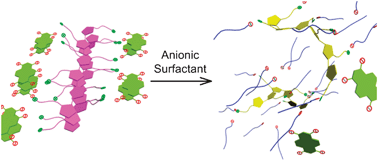A complex of a poly(3-alkoxy-4-methylthiophene) derivative, poly(3-(4-methyl-3′-thienyloxy)propyltrimethylammonium) (PMTPA), and an anionic dye, 8-hydroxy-1,3,6-pyrenetrisulfonic acid trisodium salt (HPTS), has been prepared and applied as a colorimetric and fluorometric probe for the detection of anionic surfactants. The formation of the PMTPA/HPTS complex and its colorimetric and fluorescent responses towards anionic surfactants have been studied by absorption and emission spectroscopy. It was confirmed that the introduction of HPTS into PMTPA aqueous solution led to the formation of a PMTPA/HPTS ion-pair complex along with a solution color change from yellow to pink. Addition of anionic surfactants into the PMTPA/HPTS aqueous solution resulted in the disassembly of the complex, and a dramatic color change along with the recovery of HPTS emission were observed. Therefore, the complex can be applied as a colorimetric and fluorescent probe for detecting anionic surfactants with high selectivity and sensitivity. Besides the advantage of visual detection, the detection limit can be extended to of the order of 10−9 M by using fluorometry.

You have access to this article
 Please wait while we load your content...
Something went wrong. Try again?
Please wait while we load your content...
Something went wrong. Try again?


 Please wait while we load your content...
Please wait while we load your content...